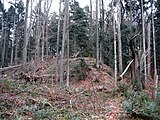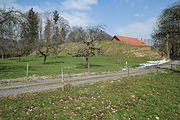Ringgenburg (Schmalegg)
| Ringgenburg | ||
|---|---|---|
|
Inner wall of the Ringgenburg |
||
| Alternative name (s): | Rinkenburg, Schwedenschanzen | |
| Creation time : | Iron Age (?) | |
| Castle type : | Hilltop castle | |
| Conservation status: | Ditches, walls | |
| Place: | Schmalegg | |
| Geographical location | 47 ° 48 '39.9 " N , 9 ° 32' 46.5" E | |
| Height: | 570 m above sea level NN | |
|
|
||
The Ringgenburg , also called Rinkenburg , is a hill fort and Fliehburg in the Schmalegger Tobel near the Schmalegg district of the city of Ravensburg in the Ravensburg district in Baden-Württemberg .
description
The hilltop castle is located on an approximately 1.5 kilometers long and 100 meters wide tongue at 570 m above sea level. NN of the Schmalegger Tobels. Three earth walls with trenches to the west have been preserved on it. The entire area protected by ramparts and moats covers around 10 hectares . Possibly the walls were additionally secured by palisades, hedges and stone bolts.
Outer wall
According to a report from the time when the fortifications were still more untouched than they are today, the outermost earth wall of the complex was about 900 meters west of the top of the ridge, sometimes still eight meters high. The pointed ditch upstream to the west was deeper and wider than that of the middle wall.
Middle wall
About 660 meters before the end of the ridge there is another earth wall, now located in the middle of the forest, which once had a ditch on its western side with an earth ejection in front.
dig
There was a ditch a hundred meters west of the inner double wall and thus 300 meters before the top of the ridge, which has now been leveled. A thorn barn or a palisade is suspected here.
Inner wall
The innermost wall of the complex consisted of a fore wall and a main wall behind it. The flat three to four meter high wall was 265 meters, the eight meter high main wall 200 meters from the tip of the mountain tongue.
middle Ages
The Schmalegger Ringgenburg used to be associated with the Ringgenburg near Esenhausen . Since a medieval castle was built on it, this was also assumed for the Schmalegger Ringgenburg. So far, however, no evidence of this has been found.
The Schmalegger knights and later taverns had not built a castle on the Schmalegger Ringgenburghöhe either. Your ancestral castle stood on the eastern tip of one of the hill ridges in front of the Ringgenburg. However, there were family ties between the Schmalegger knights and taverns and the knights of Rinkenburg (near Esenhausen) through the ministerials of Biegenburg (Beyenburg) near Blitzenreute .
At the time of the Hungarian invasions , however, the inner wall could have been raised further.
Schwedenschanzen
The name Schwedenschanzen does not refer to the builder of the facility. Rather, it is derived from the Swedish troops who set fire to Schmalegg Castle from this point during the Thirty Years' War in spring 1647 .
Age
When the Ringgenburg was built can only be guessed without scientific excavations:
- Alfons Dreher suspected the late Hallstatt period or even the La Tène period as the time of origin.
- The Weingarten vice-principal i. R. and the representative of the Archaeological State Office Paul Eith placed the construction of the Ringgenburg in the Hallstatt period, which is considered to be the beginning of the Iron Age .
Todays use
Today the plateau is used for agriculture. Hof Schmucker is located behind the innermost, third wall.
Further ramparts in the Schmalegger Tobel
Another small ring wall is located on the ridge called Adelegg , southwest of the Adelmühle.
literature
- Hans Ulrich Rudolf (eds.), Berthold Büchele, Ursula Rückgauer: Places of rule and power - castles and palaces in the Ravensburg district . Jan Thorbecke Verlag, Ostfildern 2013, ISBN 978-3-7995-0508-6 , pp. 337–338.
- Josef Schmid: The beautiful Schmalegg. Homeland book. Alfons Holzschuh, Ravensburg 1963.
- Pastor Pfister. Initial description. The Observer - a people's paper for Württemberg, issue of August 10, 1896
Web links
Individual evidence
- ↑ a b c d Josef Schmid: The beautiful Schmalegg. Homeland book. Alfons Holzschuh, Ravensburg 1963; Pp. 25-26
- ↑ a b Paul Eith, manuscript "The Ringgenburg and the graves in the Dickenwald"
- ↑ Hans Ulrich Rudolf (ed.), Berthold Büchele, Ursula Rückgauer: Places of rule and power - castles and palaces in the district of Ravensburg , p. 338
- ^ Alfons Dreher (1896–1980), city archivist of Ravensburg, manuscript "From the history of Schmalegg"







